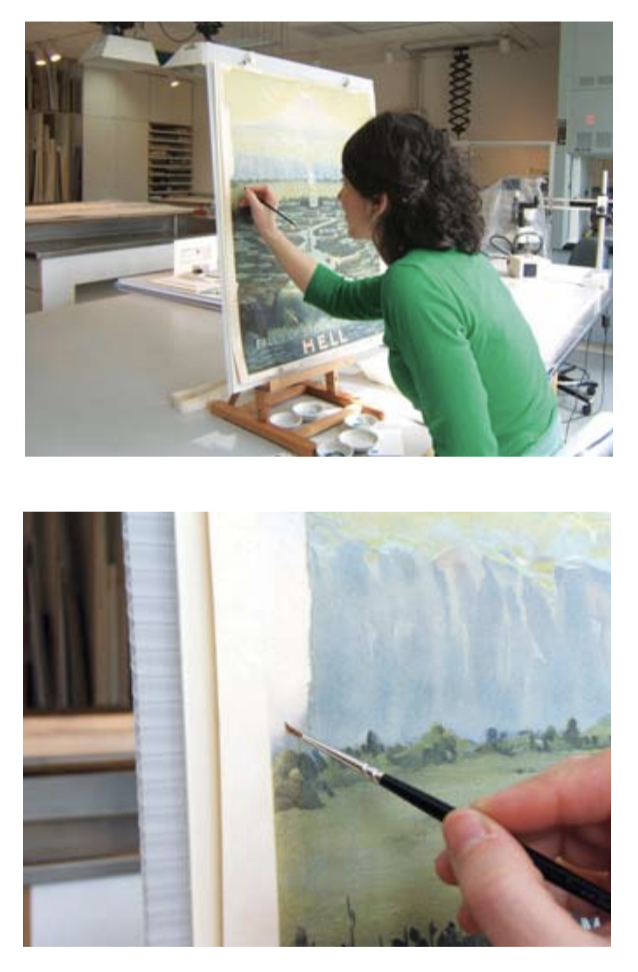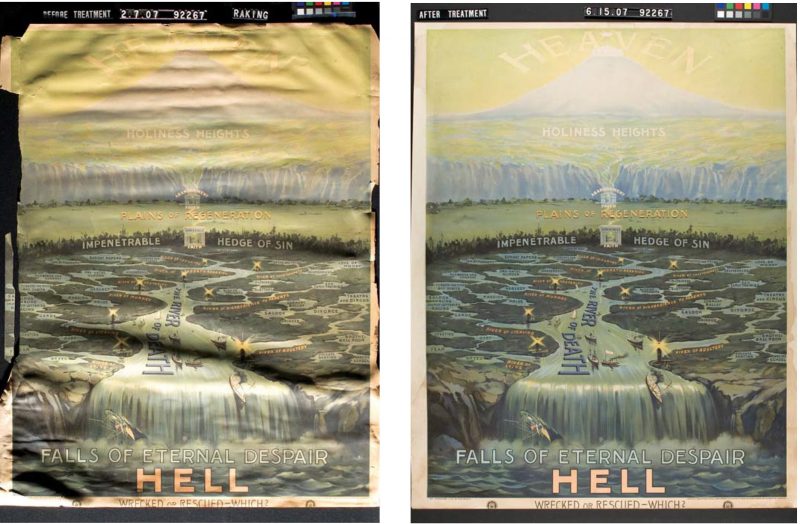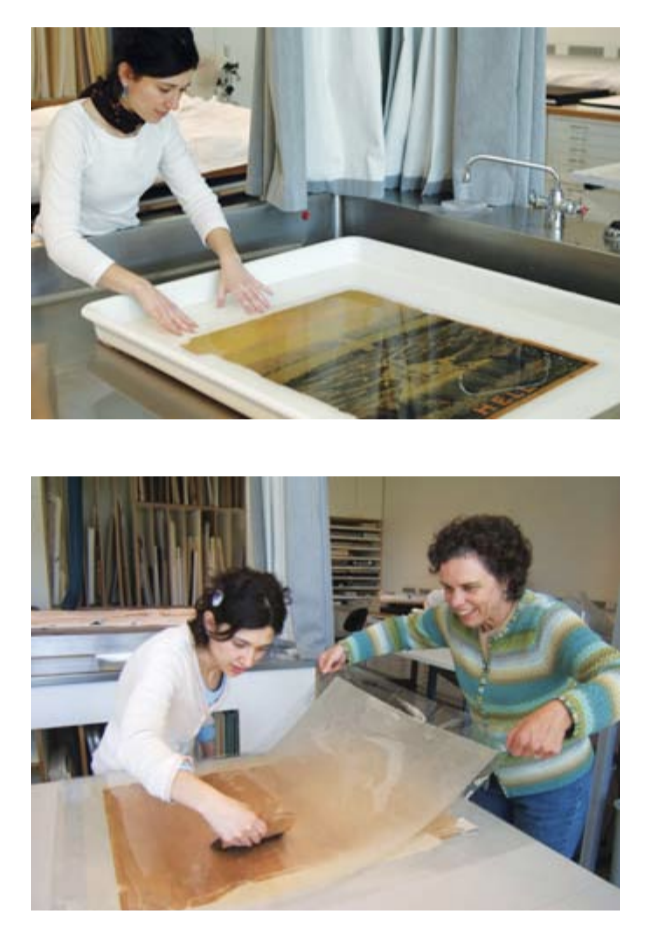The paper conservation laboratory at the Fine Arts Museums of San Francisco (the de Young and the Legion of Honor museums) oversees the preservation and treatment of a vast collection of prints, drawings, and photographs. To protect art for future generations, conservators restore damaged art and take precautions to prevent decay. The following budget, by conservators Victoria Binder and Debra Evans, details the cost of restoring one print for the museums.
The Falls of Eternal Despair is a rare chromolithograph from 1892. Chromolithographs were an early form of commercial color prints in which multiple smooth stones were used to stamp a full range of colors on paper. This chromolithograph was printed in Cincinnati by the Publishing House for Holiness Literature, the brainchild of Methodist minister Martin Wells Knapp. It arrived at the paper conservation laboratory in a state of extreme deterioration. The paper was discolored, stained, and brittle, with numerous losses and breaks.
Despite its nearly irretrievable state, something about the print’s peculiar depiction of a bizarre moral landscape captivated conservators Binder and Evans, and they decided to repair it. This budget is presented in two sections: materials and labor. As one can see from the list of expenses, the materials used for treatment are fairly affordable. The expertise of the art conservators, however, is a scarce resource. Conservation efforts can vary in scope and complexity, depending on the damage. This was a complex treatment.
This is an installment of Creative Accounting, an ongoing series that explains where the money goes for projects in the major creative industries. Very soon the series will be collected into a single, indispensable volume, published by Believer Books.
—Christopher Benz, Victoria Binder, and Debra Evans
Restoration, The Falls of Eternal Despair
$1,308.16

Victoria Binder and Debra Evans in the laboratory, from top: immersing print in a water bath, lining artwork with
kozo paper, and inpainting areas of loss. Photographs courtesy of the Legion of Honor paper conservation laboratory.
Materials $167.26
Cleaning/Prep $85.18
Grated Vinyl Eraser, 1oz $1.62
As a first step to treatment, this is used to pick up surface grime.
Extra Heavyweight Blotting Papers, 100% cotton (x4) $67.32
Damp blotters are used in the first step of bathing a fragile artwork. Later, in the last step of flattening the page, conservators use dry ones.
Deionized, Calcified Water $0
Tap water is run through a deionizing system and then over calcium chips to make it suitable for bathing artwork. After blotting, conservators immerse the print in a full bath.
Hydrogen Peroxide, 30% solution, reagent grade, 5ml $12.64
After bathing, a local application of a pure grade of hydrogen peroxide bleaching solution reduces the severity of dark stains.
Magnesium Bicarbonate (trace) $0
This chemical raises the pH of the bleaching solution and bath water. This helps remove acids from the paper and reduce discoloration. The trace amount costs fractions of a cent.
Japanese Bamboo Brush $3.60
For applying the bleaching solution. This bamboo brush is used because it is important that the brush not have a metal ferrule (the collar connecting the brush head and handle).
Paper Restoration $57.30
Usu Mino Kozo Paper (x2) $34.64
Lining to reinforce the paper. This pure, thin but strong, long-fibered, translucent paper is pasted to the back of fragile artworks.
Wheat Starch, 45g $0.26
Pure wheat starch (wheat flour with the gluten removed) is mixed with deionized water to make the paste used for attaching the lining. This paste is easy to remove if necessary.
.0029” Hollytex Fabric (x2 yds) $16.40
Hollytex is a non-woven synthetic fabric. This strong but flexible material is used to support fragile artworks when they are wet and extremely vulnerable.
Transparent Polyester Film (x2 yds) $6
When working on pulp filling over a light table, this transparent support is essential. Conservators also use the sheet of mylar to carry the kozo paper used for the lining, peeling the mylar away after transferring the lining onto the print.
Pulp Slurry $0
Deionized, Calcified Water $0
Old Paper $0
Conservators sift through a stock of old papers for paper that matches the artwork’s paper type. They beat it in a blender with deionized water to create a pulp slurry. This slurry fills the “losses” in the artwork.
Cellulose Powder (trace) $0
This powder is used to fill small losses in the cracks of the paper following repair. Conservators toast the powder on a hot plate until it matches the color of the artwork. While the trace amount used costs fractions of pennies, a 250g jar costs about $10.

Color Restoration $24.78
Ethyl Alcohol, 90%, 100ml $2.97
Applied in a vapor chamber over a sheet of felted Goretex, this solvent reforms the coating that blanched (whitened) during wet treatment. The Goretex allows the vapor to permeate, but not wet up, the artwork.
Watercolors, High Grade (trace) $0
Watercolors are used in the inpainting (or retouching), process. These specific watercolors come in a dry pan, rather than a tube.
Fine Sable Watercolor Brush $9.81
This watercolor brush, the Windsor Newton Series 7, (size 000), was handmade in England. Its sable tip will maintain a perfectly fine point during the application of the thousands of tiny dots that comprise the inpainting portion of the project.
Pastel & Colored Pencils (trace) $0
Sharpened to fine points, these pencils are used to adjust colors during inpainting
Matting $12 Acid-Free Rag Matboard (x2) $12
A thick posterboard frames the print. It is called “rag” matboard because manufacturers once made fine paper from linen or cotton rags.
Labor $1,140.90
Stipend $1,140.90
Victoria Binder, a graduate student on a one-year paid fellowship, did most of the treatment over a period of 80 hours. Her stipend for this work comes to $14.26 an hour, and this represents two weeks’ share. Debra Evans, the museums’ head of paper conservation, supervised Binder’s work.
TOTALS
Materials $167.26
Labor $1,140.90
Grand total $1,308.16






